Cinemeccanica Going 3-strip Again
|
Read more
at in70mm.com The 70mm Newsletter |
| Written by: Thomas Hauerslev with Howard Rust and Pictureville's BKSTS Projection Team Of The Year 2002 | Date: 6 March 2006 |
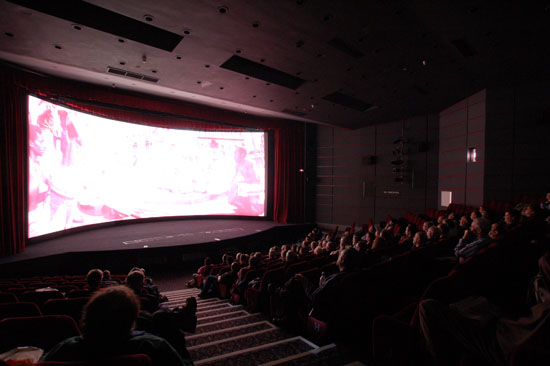 The
Pictureville cinema, the jewel of British cinema in Bradford, West
Yorkshire in the heart of Great Britain, is one of three cinemas
equipped to show Cinerama in the original 3-strip format [There are two
additional 3-strip cinemas, Seattle Cinerama and the
Cinerama Dome in
Los Angeles and a private in a back yard in Australia]. The
Pictureville cinema, the jewel of British cinema in Bradford, West
Yorkshire in the heart of Great Britain, is one of three cinemas
equipped to show Cinerama in the original 3-strip format [There are two
additional 3-strip cinemas, Seattle Cinerama and the
Cinerama Dome in
Los Angeles and a private in a back yard in Australia]. |
More
in 70mm reading: Cinerama Films Widescreen Weekend 2006 • Gallery: 2006 • WSW Home • Through the Years • The Best of WSW • Academy of the WSW • Creating the WSW • Planning the WSW • Projecting the WSW • Home of CINERAMA • Projecting CINERAMA Internet link: Pictureville Cinema National Media Museum Bradford BD1 1NQ England “The Cinerama Adventure” |
Prelude |
|
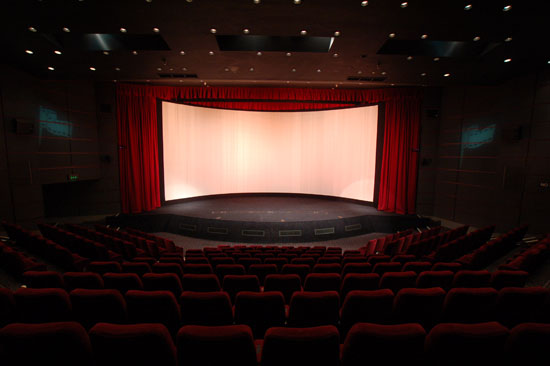 Cinerama
screen. Image by Thomas Hauerslev Cinerama
screen. Image by Thomas HauerslevIn 1992 the management of the National Museum of Photography, Film and Television where Pictureville is located, courageously announced that an authentic, three projector, seven track sound Cinerama installation would be its newest attraction. Easier said than done as most of the equipment used 40 years ago was thought to have been destroyed by the owners of Cinerama. Luckily, thanks to collectors around the globe, this giant jig saw puzzle was completed by June 1993. |
|
First Person Experience |
|
 For the modern cinema audience, who are used to flat screens and motion
pictures filmed with long focal length lenses, the narrative is
experienced through the characters in the film. This is known as a third
person experience. For the modern cinema audience, who are used to flat screens and motion
pictures filmed with long focal length lenses, the narrative is
experienced through the characters in the film. This is known as a third
person experience.Pictureville and Cinerama offer a unique opportunity to experience “peripheral vision” or what is known as a “first person experience”. What you see on the screen is an illusion of reality – you participate in the action for example, from the front of a rollercoaster. By imitating human vision Cinerama gives a sensation of “You are in the movies” – as the cliché goes. It is achieved with the deeply curved screen and the extreme wide angle of photography. “Cinerama puts you in the picture” is best experienced by sitting on the first 4 rows, closest to the screen, claims the Cinerama buffs. A unique attraction, that has made Pictureville cinema world famous. |
|
A Cinema Museum |
|
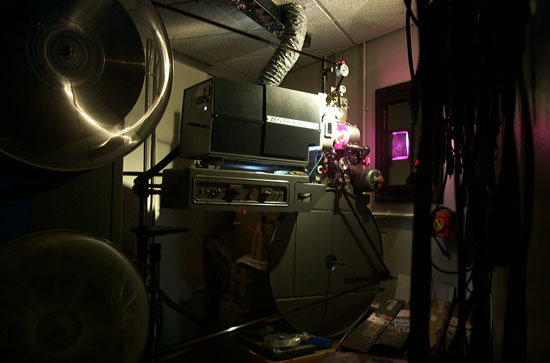 Charlie
projector. Image by Thomas Hauerslev Charlie
projector. Image by Thomas HauerslevAn impressive list of obsolete film formats can be projected in the Pictureville cinema including 3-strip Cinerama, Dimension 150, Ultra Panavision 70 as well regular 70mm and 35mm. There are two screens, an original permanent 146-degree louvered Cinerama screen and a flat roller screen for regular film projection. Pictureville cinema can display an impressive line-up of projection equipment: 4 Cinemeccanica Victoria 8 machines (3 x Cinerama and 1 35/70mm), the Oscar winning DP70 Todd-AO projector, a 5-deck Cinemeccanica platter as well as a Cinemeccanica 7-track Cinerama magnetic sound reproducer. With this impressive collection of equipment and unique screen and sound technology, it is indeed possible to show nearly all conceivable film formats in Pictureville. |
Originally there were more than 150 3-strip installations scattered all over the globe. |
Pictureville Cinema |
|
 Able
projector. Image by Thomas Hauerslev Able
projector. Image by Thomas HauerslevThe cinema opened April 8, 1992 with a charity performance of Steven Spielberg´s "Hook" in 35mm and Dolby SR stereophonic sound only – digital sound was added shortly after. Since 1994, Pictureville has been the home of the "Widescreen Weekend", an annual event celebrating the wonders of the big screen. The weekend draws a huge cast of wide screen enthusiasts from all over the world. Nearly all of the original 3-strip Cinerama films have been shown during the past 10 years. All films believed to have been lost forever, have seen new projector light in Bradford thanks to its Cinemeccanica projectors. |
|
Who Did It? |
|
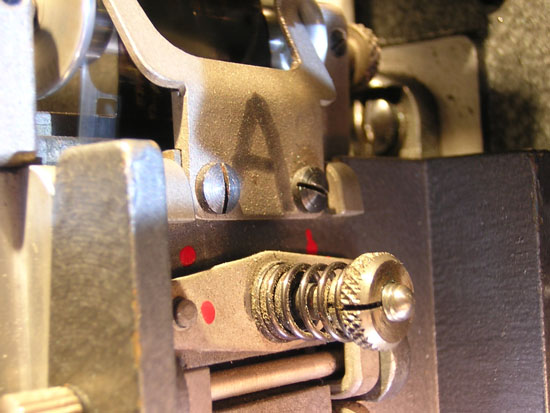 Able
projector. Image by Thomas Hauerslev Able
projector. Image by Thomas HauerslevTechnical Cinerama consultants Willem Bouwmeester, Keith Swadkins and John Harvey did the Cinerama installation. All missing projector- and sound parts were collected from • Helsinki, Finland (7-track 35mm sound reproducer) • Bruxelles, Belgium (louvered screen supports) • Paris, France (handmade sprockets by Cinemateriel) • London, England (Sound Associates) • Los Angeles, USA (Teccon Enterprises) • Milan, Italy (drawings by Cinemeccanica) and finally from • England and USA (louvered screen) It was an enormous task of tracking down, and locating, the almost non-existent components necessary to re-create an authentic Cinerama installation. By happy chance, the museum already had two Cinemeccanica Victoria 8 (former Cinerama) projectors. These had to be restored again to the unique six-perforation “pull-down” and the discarded “gigolos” re-installed. A third projector was located in Glasgow and shipped to Bradford. The company that made the louvers for the original screens searched their storerooms and found a complete set. Unfortunately, these proved to be too short. The search for another supplier was resumed, and one was eventually located in the United States. The re-release of "This is Cinerama" took place June 16, 1993. Present at that performance was Doris Waller, widow of Fred Waller, the inventor of Cinerama. |
|
The Cinema and Auditoria |
|
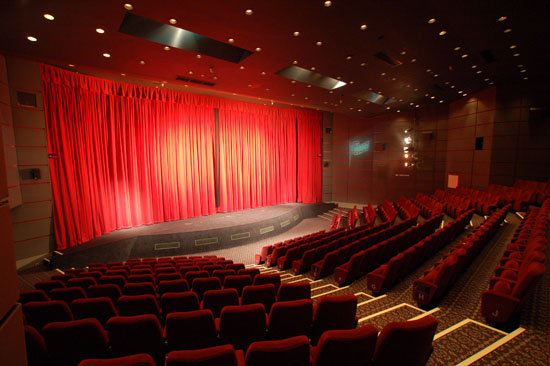 The
cinema. Image by Thomas Hauerslev The
cinema. Image by Thomas HauerslevThe cinema is built inside the shell of an ex repertory theatre and the customers enter through the NMPFT main entrance. Once inside, you are greeted by friendly staff and a classic GK21 35mm projector which was made locally by the Gaumont Kalee factories in Leeds. There is a bar behind the projection area with a pleasant range of snacks, sandwiches and beverages. There are two entrances to the cinema on both sides of the B-projection room. Inside you find yourself "surrounded" by 3 projection rooms and KCS surround speakers. The colours are kept in grey and red. Pictureville has 306 seats including a space for 2 wheel chairs. The seating area is amphitheatrical and the view to the screen is unobstructed by the viewer in front of you. Row A is the first row nearest to the screen(s). There are 12 rows A through M (I is missing). |
|
Projection Room |
|
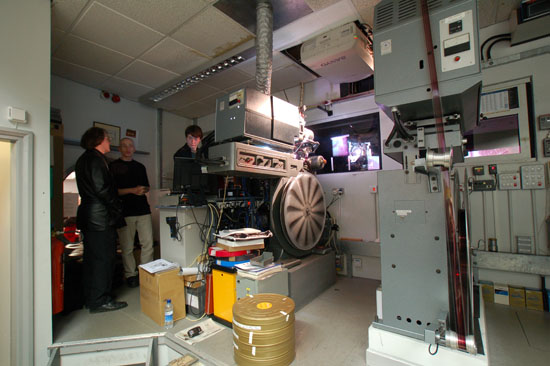 Cinemeccanica
Cinerama machine. Image by Thomas Hauerslev Cinemeccanica
Cinerama machine. Image by Thomas HauerslevThe projection rooms are all kept very clean. The Cinerama boxes Able and Charley, situated in opposite sides of the cinema are clearly visible from the auditoria and equipped with a Cinemeccanica Victoria 8 Cinerama projector and a tower with the large reel of film. Baker is also equipped with a 5-deck platter, a 35mm/70mm Cinemeccanica Victoria 8 projector, a Philips DP70 and the third Victoria 8 Cinerama projector. The Cinerama B panel is fed from the 5-deck CNR-5 70/35 platter. The large Cinemeccanica Cinerama 35mm sound reproducer with a new sound head manufactured by Teccon, is also installed in Baker. |
|
Screen Technology |
|
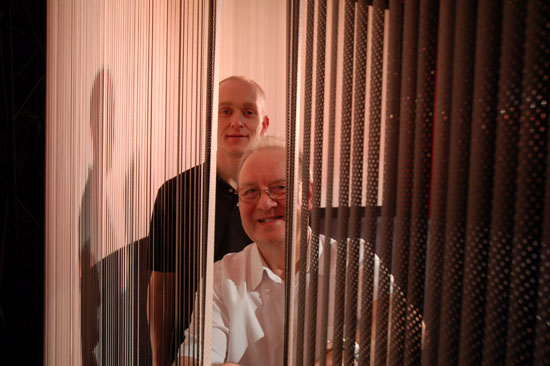 Duncan
and Tony lookign through the louvred Cinerama screen. Image by
Thomas Hauerslev Duncan
and Tony lookign through the louvred Cinerama screen. Image by
Thomas HauerslevThe screen technology is very sophisticated. For ordinary film presentations a 10,2m (33’5") wide and 4,6m (15’2") tall flat roller screen from Harkness Ltd in England is used. Behind the roller screen are 5 speakers for 5 channel sound reproduction. All regular movie presentations are shown on this screen. The unique feature of Pictureville is the screen behind the roller screen. Not only are two sets of projectors installed, but also two sets of screen/speakers and curtains. The giant louvered Cinerama screen is revealed when the roller screen and speakers are hoisted into the ceiling. The roller screen is manually controlled from behind the screen. The Cinerama screen is made of 1360 guided louvers each angled to the audience and the relevant projector. It is designed this way to keep cross reflection to a minimum. The louvered 146° Cinerama screen (Hurley Screen, Inc., Baltimore, USA) measures 146° horizontally and 55° vertically. It is 15,6m (51’2") wide along the curve and 5,9m (19’5") high. Depth of curvature is 3,9m (12’11"). Screen chord is 13,0m (42’8"). Throw to centre of screen chord of Cinerama screen 18,1m (59’4"). The aspect ratio is 2,62:1. The relative aspect ratio seen from the Baker projector is 2,24:1 with a heavy butterfly effect because of the curvature. Behind the screen are 5 speakers installed in a THX-like wall for discrete stereophonic Cinerama sound. Both screens are covered by a "Cinerama Red" curtain. |
|
Projection Technology |
|
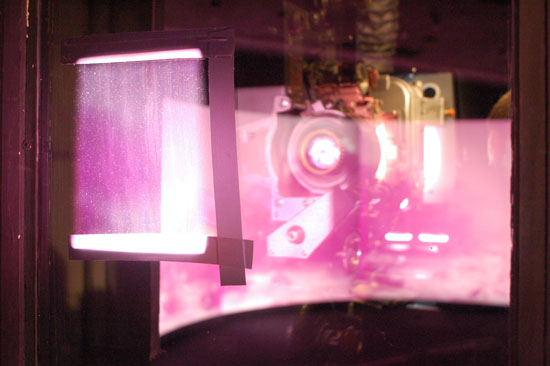 Projecting
Cinerama. Image by Thomas Hauerslev Projecting
Cinerama. Image by Thomas HauerslevCinemeccanica Victoria 8 Cinerama projectors (Able, Baker & Charlie) electronically locked together by Selsyn motors. 3000 watt/110 amps Osram xenon on each Cinerama projector. 4500 watt/140 amps Osram xenon on the Victoria 8 70/35. 3600 watt xenon on the DP70. 3-strip Cinerama is operated by two projectionists. Projection lenses are from Schneider and ISCO with zoom lenses on Able and Charlie. Focal length on lens for flat screen 70mm film is 85mm. Focal length for 70mm on Cinerama screen is 65mm. |
|
Sound Equipment |
|
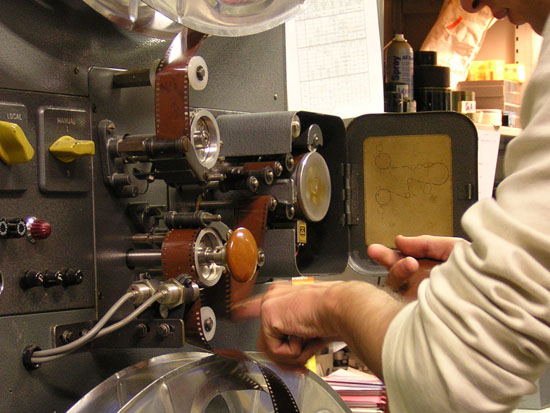 Sound
is played separately. Image by Thomas Hauerslev Sound
is played separately. Image by Thomas HauerslevCinemeccanica A6 Cinerama 35mm magnetic sound reproducer with specially made Teccon 7-track Cinerama head. Dolby Stereo CP200 cinema sound processor. Dolby MPU-1 (Magnetic sound). Dolby SRA5 Spectral Recording. Dolby DA20 Dolby Digital. Dolby SA10 for Surround-EX. Sony Dynamic Digital Sound DFP-D2000 processor (SDDS). Digital Theater Systems DTS-6D processor for standard 5.1 and special venue 6 channel (DTS). 10-KCS surround speakers. Electro Voice screen speakers. One set of 5 screen channels behind both screens. Amplifiers: 3-QSC USA 1300 (2x650 Watt) for screen speakers and 3-QSC USA 850 (2x425 watt) for subwoofer and surrounds. |
|
Contact information |
|
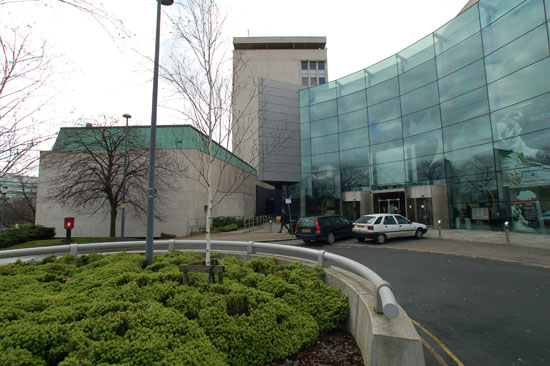 Pictureville
Cinema is managed by National Museum of Photography, Film and Television in
Bradford (NMPFT). Pictureville
Cinema is managed by National Museum of Photography, Film and Television in
Bradford (NMPFT). Pictureville Cinema NMPFT Bradford BD1 1NQ England Phone: +44 (0)870 70 10 200 |
|
Cinerama fact |
|
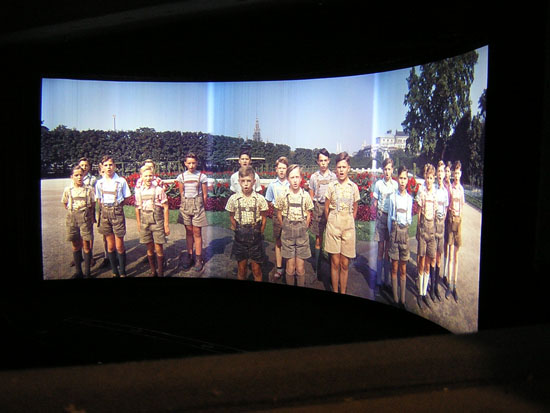 Projecting
seen from the cinema. Image by Thomas Hauerslev Projecting
seen from the cinema. Image by Thomas HauerslevThree films shot simultaneously with one special camera and shown on three 35mm projectors in the cinema. 3 x 35mm, 6 perforations per frame and 1 x 35mm full coat magnetic 7 track stereo sound. Film speed is 26 (twenty-six) frames per second, with the option to switch to 24 frames per second for selected films. Invented by Fred Waller in the late 1930’s, refined in the 1940’s and commercialised with the opening of “This is Cinerama” September 30, 1952 at the Broadway Theatre in New York, USA. The three-strip format was abandoned in the early 1960’s and was generally replaced by regular 70mm projection, much to the dismay of Cinerama purists and fans all over the globe. David Strohmaier, has recently documented the fascinating history of Cinerama in the film, “The Cinerama Adventure”. |
|
Pictureville “This is Cinerama“ opening procedure |
|
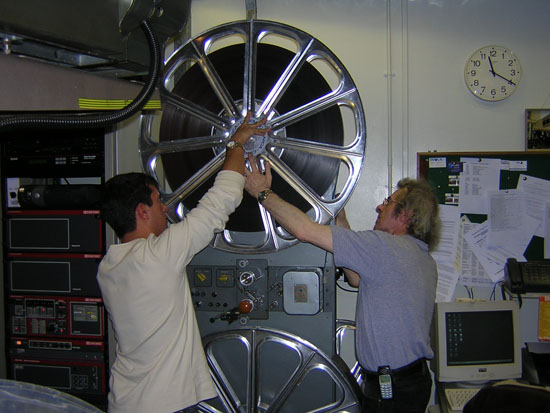 The
sound reel. Image by Thomas Hauerslev The
sound reel. Image by Thomas HauerslevTo illustrate the complex nature of running 3-strip Cinerama, here is the projectionists checklist to run the show. Open prologue as normal, mono 5.5 Check it. Magnetic (40) 7.5 "Strike lamp when Indians on horses scene appears" Change over cue is: "In fact what you are now going to see is an ENTIRELY new form of entertainment" On "ENTIRELY" push projector start Then when Lowell Thomas says: "Ladies and gentlemen this is Cinerama" Push sound, tabs open Wait for 1st sound bar, Victoria 8, shutter closed, Cinerama shutter open. “This is Cinerama“, 1st part closure Tab when: After actors take a bow, it changes to the theatre/balcony’s, everyone clapping Bring 1st red up with house lights up to low when curtains are half closed. As curtains close, close projector shutters as soon as possible. Bring remaining lights up, and fade sound down. This part has no play out. Inch projector over till sprocket stops moving. |
|
Pictureville “This is Cinerama“ part two, opening |
|
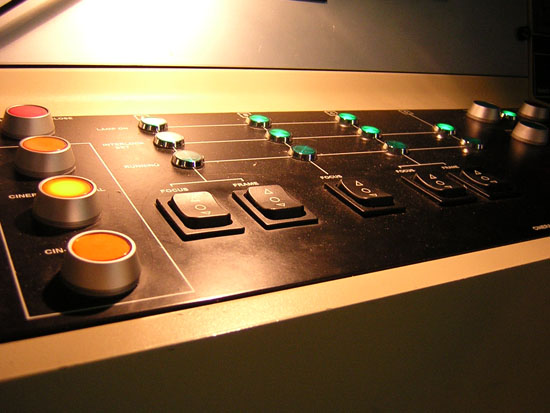 Once laced and ready set sound to back wall for Lowell Thomas "Quiet", then
play normal sound Once laced and ready set sound to back wall for Lowell Thomas "Quiet", then
play normal soundStart projectors Bring sound up when blue spacing enters projector - 7,5 on fader. Strike lamps 2 minutes into playing. When Lowell Thomas says: "Listen to the tremendous power" - take house lights out. Open tabs and shutters at the end of the play in. Take reds out as curtains open Check picture and film “This is Cinerama“ part 2, closure Tab when Cameraman Harry Squire fades to screen Bring 1st red with house lights up low when curtains are half closed Close shutters and bring remaining lights up when curtains touch Play out on end. |
|
|
Go: back
- top -
back issues
- news index Updated 22-01-25 |
|
